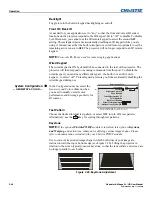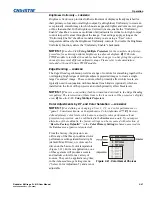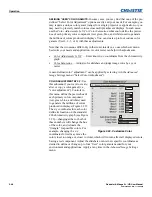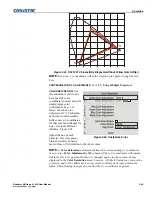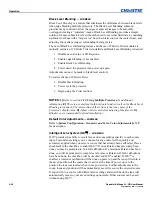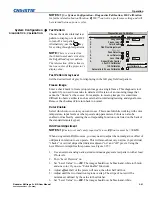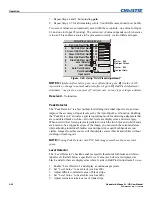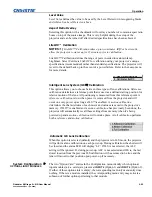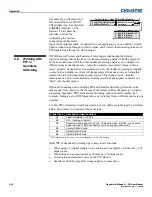
Operation
Roadster & Mirage S+/HD User Manual
3-39
020-100002-04 Rev. 1 (12-2008)
shutters in 3D glasses, a total frame delay setting of two (or multiple of two) may be
more useful. If set too high or low, frame locking will not be possible—most sources
require approximately 50 lines of delay to ensure frame locking.
ACCUFRAME
– Increasing the AccuFrame value will reduce the artifacts related to
fast motion in simulation content. Symptoms of blurry objects or loss of apparent
detail may indicate a need for this value to be adjusted.
NOTE:
If increasing AccuFrame does not improve image quality, reduce the value to
0. Increasing AccuFrame may increase ‘flicker’ of the display and may reduce
overall brightness.
FRAME LOCK ENABLE
—
This option allows the projector to control the output frame
timing based on the input signal. The
locked
option forces (if possible) the output
image to be phase locked to the input frames.
Rate Matched
means that the output
runs at close to the input frequency but isn’t locked to it so the output will drift in
phase relative to the output. Free Run forces the output to run at a 60Hz frame rate.
Reserved -
No function.
WARP LATENCY
—
Requires optional
ChristieTWIST
module. See
ChristieTWIST
User Manual
provided with the module.
Advanced Image Settings continued
— SUBMENU
MOTION FILTER
—
This control is most useful for smoothing out moving images from
interlaced sources. In most cases the proper Motion Filter setting is
automatically determined according to the type of incoming source
signal. However, if your source is jittery and/or tearing you may wish
to “force” a setting to ensure stable processing for this source—if
desired, override the default “Auto” setting by selecting the
appropriate motion filter:
1.
AUTO:
The projector will automatically use the correct motion filter according to
the incoming signal.
2.
STILL:
For static images with no motion, such as graphics from a CD.
3.
MOTION:
For video images that did not originate from film, or for moving
computer-generated images.
4.
FILM:
For video images that originated from film. This will optimize image
quality and stability.
FILM MODE THRESHOLD
—
This setting determines how sensitively the projector can
detect if an incoming video signal originated from film or not. It should not require
adjustment.
DETAIL THRESHOLD
— Use “Detail Threshold” to define at what frequency level the
“Detail” control will begin to magnify high frequencies, which adds details back into
the image. Raise the threshold to
ignore
more of these high frequencies, and lower
the threshold to
magnify
more of these frequencies. A setting of “0”, for example,
means no noise will be ignored and all will be magnified. An ideal detail threshold is
one in which high frequencies that are causing objectionable noise are
not
magnified
when using “Detail”, but frequencies which can help sharpen an overly-soft image
are magnified.
3D SOURCE
—
When using a Mirage projector with HD resolution, a checkbox
option called
3D Source
will be added to the bottom of the
Advanced Image Settings






















